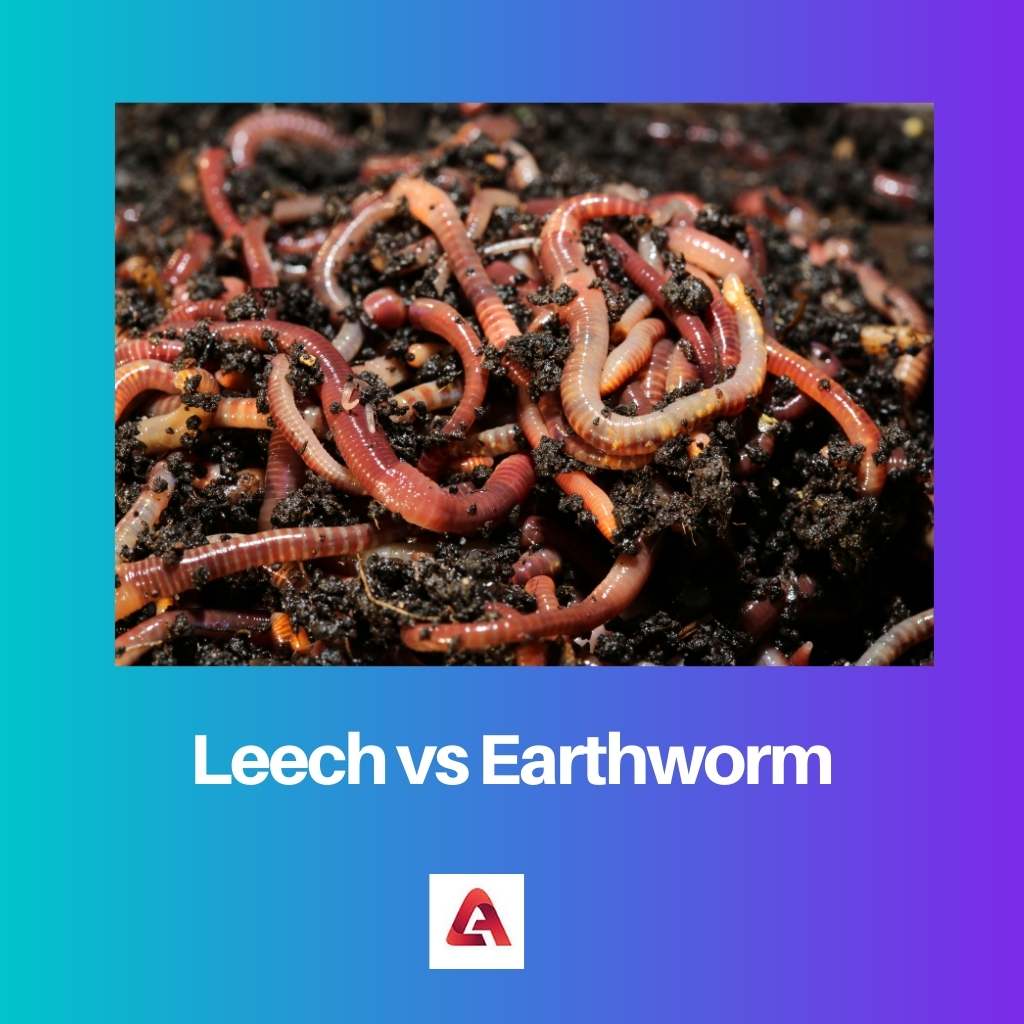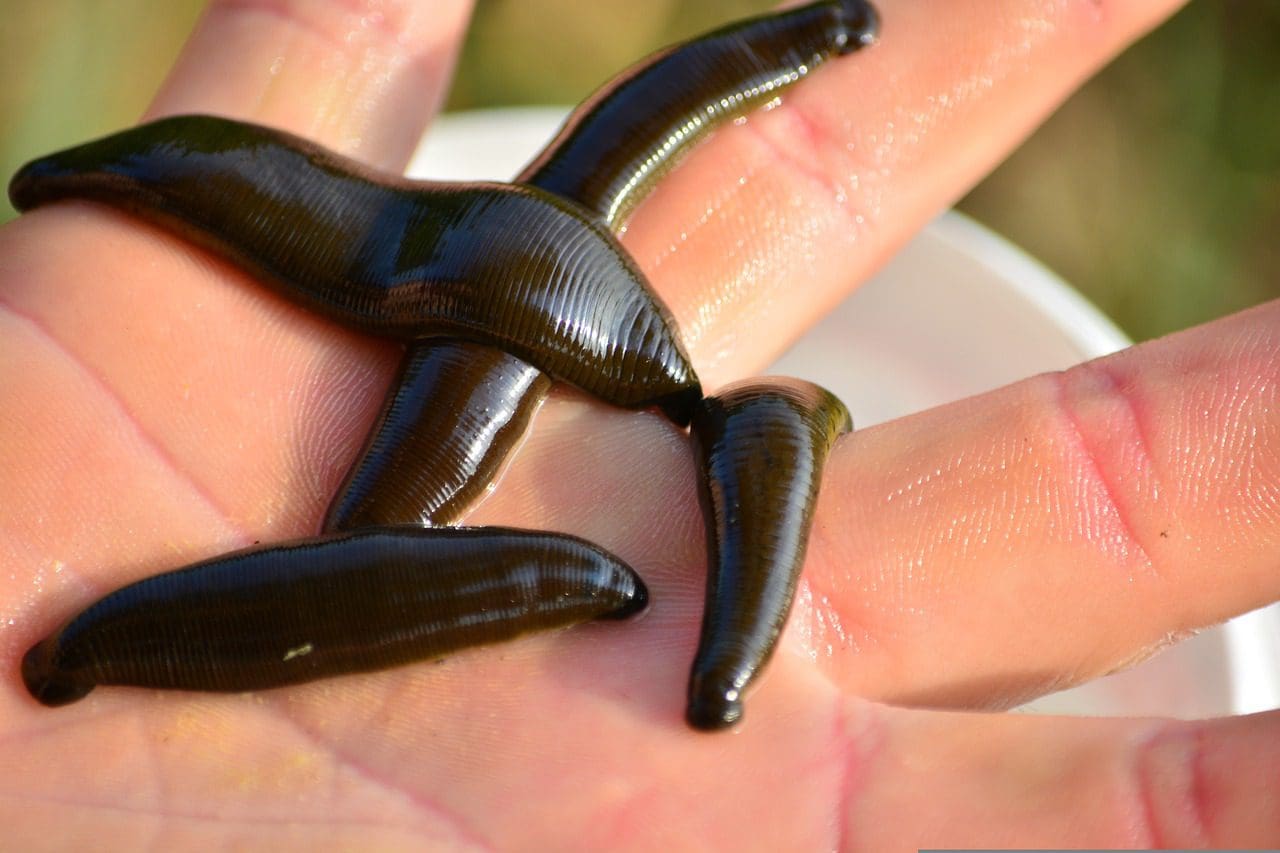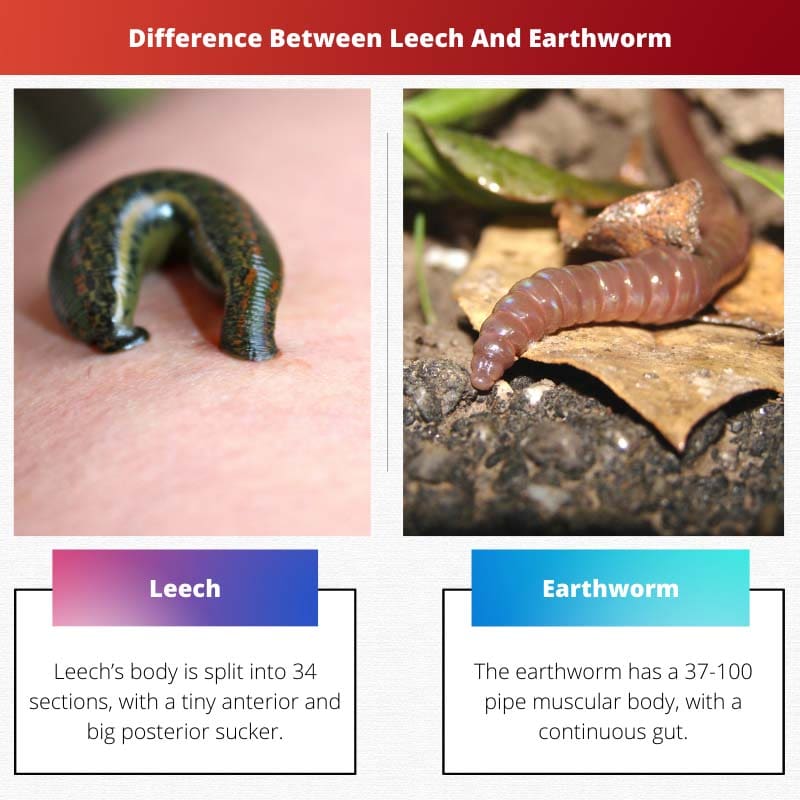Leeches and Earthworms are both invertebrates known as annelids. These are delicate worms with segments that divide their bodies into sections.
Each section has a distinct set of organs. The majority of annelid species move by compressing the muscles in these segments one by one.
Earthworms and leeches are helpful worms belonging to the same class, yet they have distinct distinctions.
Key Takeaways
- Leeches are parasitic and feed on blood, while earthworms are not parasitic and feed on decaying organic matter.
- Leeches have suckers at both ends of their body and secrete an anti-coagulant to prevent blood from clotting, while earthworms have bristles on their body and aid in soil aeration and nutrient cycling.
- Earthworms are beneficial to the environment, while leeches can transmit diseases.
Leech vs Earthworm
Leeches are elongated, segmented, blood-sucking worms that belong to the annelid family, and are commonly found in freshwater habitats. Earthworms are also annelids, but they are not blood-suckers, they are burrowing worms that are found in soil and play an important role in maintaining soil health.

Leeches are members of the Phylum Annelida’s Class Clitellata and Subclass Hirudinea. They are worm-like organisms with divided bodies that are flattened dorsoventrally with suction discs on either end.
The mouth of the head sucker, which is placed at the extremity of the body, is equipped with sharp cutting beaks. The sucker towards the back of the body serves as an anchor for the leech.
Earthworms are members of the Phylum Annelida’s Class Clitellata and Subclass Oligochaeta. There are more or less 6000 kinds of earthworms found throughout the world.
They feature a segmentation, tube-like structure made up of annuli, which are ring-like sections. A continuous stomach, a nerve, and a blood artery link these parts.
The mouth is located in the body’s first section.
Comparison Table
| Parameters of comparison | Leech | Earthworm |
|---|---|---|
| Division | Members of the Phylum Annelida, Family Clitellata, and Subfamilies Hirudinea | Phylum Annelida, and Subclass Oligochaeta |
| Morphology | Leech’s body is split into 34 sections, with a tiny anterior and big posterior sucker | The earthworm has a 37-100 pipe muscular body, with a continuous gut |
| Diet and nutrition | Feed on blood, open wounds, etc., | Feed on organic stuff present in the soil |
| Form of body | Flat, short form and are black in color | They have thin, elongated, spherical shape |
| Behavior and locomotion | The anterior and posterior suckers, as well as the longitudinal muscles, help them move. | They travel by contracting and relaxing muscles. |
What is Leech?
Leeches are sectioned worms that are members of the phylum Annelida and the subfamily Hirudinea. Over 700 different species of leeches may be found around the world.
The majority of the species dwell in freshwater settings, with some in saline water ecosystems and some in wet terrestrial environments.
Leeches lack setae and move by using the anterior and posterior suckers as well as the transverse muscles that run the length of their bodies.
The posterior sucker connects to the surface as the longitudinal muscles stretch and propel the leech’s body forward. At this point, the anterior sucker adheres to the surface, and the posterior one is dislodged.
Leeches are hermaphrodites, meaning they have male and female reproductive organs. The two leeches line properly and inject sperm into one another during mating.
Fertilized embryos are either preserved in a cocoon connected to the bottom of the body or deposited outdoors in the surroundings.
Before digestion begins, they may store a considerable volume of blood in their bodies, many times their own body weight.
Some species feed on their prey’s tissues, some on deceased animals’ rotting flesh, while others ingest minute invertebrates. Natural predators include fish, turtles, shorebirds, herons, and others.

What is Earthworm?
Earthworms have a tube-like body with segments connected by a continuous stomach, a nerve, and a circulation artery. The number of segments varies between species, ranging from 37 to 100.
The outside of the body is greasy and tough.
Earthworms live in the soil and are commonly observed on the surface during heavy rain. They travel by contracting and relaxing muscles, which compress and stretch the body and help in motion.
The setae or bristles on the segments of the body, as well as the mucus released, help in this motion.
The biggest Oligochaeta members are known as earthworms. Earthworms are sectioned creatures with a tube-like structure. They are members of the phylum Annelida, the class Clitellata, and the subdivision Oligochaeta.
They are hermaphrodites because they have both male and female reproductive organs. Sperms are shared between two worms during mating.
They breathe via their skin because they lack respiratory organs.
They are primarily scavengers, feeding on organic compounds such as decaying leaves, soil minerals, and so on. They take nutrients in the soil as it goes through their intestines and defecates the soil once it has been absorbed.
Castings are then expelled dirt or droppings. Earthworms may consume up to one or more of their body weights in a single day.

Main Differences Between Leech And Earthworms
- Leeches are worms that are members of the Phylum Annelida, Family Clitellata, and Subfamilies Hirudinae. On the other hand, Earthworms are large, segmented worms belonging to the Phylum Annelida and Subclass Oligochaeta.
- A leech’s body is split into 34 sections, each with a tiny anterior and big posterior sucker. On the other hand, Earthworms have a segmented (37-100) pipe muscular body linked by a continual gut, a neuron, and a blood artery.
- Some leech species feed on blood. Other species feed on amphibians, reptiles, fish, and even mammals’ rotting remains and open sores. Earthworms consume organic stuff present in the soil, such as decaying leaves and microscopic soil particles.
- Leeches have a flat, short form and are black in color. Meanwhile, earthworms have a thin, elongated, spherical shape and are whitish in color.
- Leeches are classified into three types: aquatic, terrestrial, and marine. The anterior and posterior suckers and the longitudinal muscles that run the length of the body enable leeches to move. Earthworms, on the other hand, reside mostly in the soil. They travel by contracting and relaxing muscles, which compress and stretch the body and help in motion.

- https://onlinelibrary.wiley.com/doi/abs/10.1002/iroh.200390008
- https://www.sciencedirect.com/science/article/pii/0076687989791473

I fail to understand why posts like these always come over the internet. Knowledge of this kind can very easily be obtained from books in the library. These posts are nothing but a waste of internet space.
What is the purpose of this article? I have no plans to encounter these beings in real life. Talking or them and knowing the differences between them feels like the knowledge is useless. I mean, Thanks but no thanks.
A very well-researched and organized article. Your content is very informative and beneficial. I really admire the thoroughness of your comparative study.
Thank you for providing such a clear and well-organized comparative analysis. The information is very helpful to understand the distinctions between leeches and earthworms. I feel much more enlightened.
A very informative post explaining the differences between these two invertebrates. I really appreciate the detailed comparison between leeches and earthworms. Great job!
This detailed article helps in understanding the anatomy and habits of leeches and earthworms. This is a very insightful information that many people may not be aware of.